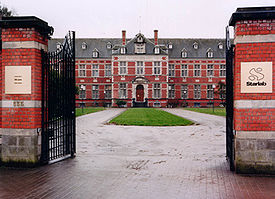
Starlab
Encyclopedia


Starlab NV/SA was a multidisciplinary, blue skies research
Blue skies research
Blue skies research is scientific research in domains where "real-world" applications are not immediately apparent...
institute in operation from 1996 to 2001 and based in Brussels, Belgium. A second base of operations, Starlab Barcelona, was established in 2000 and remains in operation.
History
At its peak, Starlab employed over 130 scientists from thirty-six nationalities. Starlab projects included intelligent clothing, stem cellStem cell
This article is about the cell type. For the medical therapy, see Stem Cell TreatmentsStem cells are biological cells found in all multicellular organisms, that can divide and differentiate into diverse specialized cell types and can self-renew to produce more stem cells...
research, emotics, transarchitecture, robotics
Robotics
Robotics is the branch of technology that deals with the design, construction, operation, structural disposition, manufacture and application of robots...
, theoretical physics
Theoretical physics
Theoretical physics is a branch of physics which employs mathematical models and abstractions of physics to rationalize, explain and predict natural phenomena...
, e.g., the possibility of time travel
Time travel
Time travel is the concept of moving between different points in time in a manner analogous to moving between different points in space. Time travel could hypothetically involve moving backward in time to a moment earlier than the starting point, or forward to the future of that point without the...
, consciousness
Consciousness
Consciousness is a term that refers to the relationship between the mind and the world with which it interacts. It has been defined as: subjectivity, awareness, the ability to experience or to feel, wakefulness, having a sense of selfhood, and the executive control system of the mind...
, quantum computation, quantum information
Quantum information
In quantum mechanics, quantum information is physical information that is held in the "state" of a quantum system. The most popular unit of quantum information is the qubit, a two-level quantum system...
, art
Art
Art is the product or process of deliberately arranging items in a way that influences and affects one or more of the senses, emotions, and intellect....
, artificial intelligence
Artificial intelligence
Artificial intelligence is the intelligence of machines and the branch of computer science that aims to create it. AI textbooks define the field as "the study and design of intelligent agents" where an intelligent agent is a system that perceives its environment and takes actions that maximize its...
, neuroscience
Neuroscience
Neuroscience is the scientific study of the nervous system. Traditionally, neuroscience has been seen as a branch of biology. However, it is currently an interdisciplinary science that collaborates with other fields such as chemistry, computer science, engineering, linguistics, mathematics,...
, new media
New media
New media is a broad term in media studies that emerged in the latter part of the 20th century. For example, new media holds out a possibility of on-demand access to content any time, anywhere, on any digital device, as well as interactive user feedback, creative participation and community...
, biophysics
Biophysics
Biophysics is an interdisciplinary science that uses the methods of physical science to study biological systems. Studies included under the branches of biophysics span all levels of biological organization, from the molecular scale to whole organisms and ecosystems...
, materials science
Materials science
Materials science is an interdisciplinary field applying the properties of matter to various areas of science and engineering. This scientific field investigates the relationship between the structure of materials at atomic or molecular scales and their macroscopic properties. It incorporates...
, protein folding
Protein folding
Protein folding is the process by which a protein structure assumes its functional shape or conformation. It is the physical process by which a polypeptide folds into its characteristic and functional three-dimensional structure from random coil....
, nanoelectronics
Nanoelectronics
Nanoelectronics refer to the use of nanotechnology on electronic components, especially transistors. Although the term nanotechnology is generally defined as utilizing technology less than 100 nm in size, nanoelectronics often refer to transistor devices that are so small that inter-atomic...
, and wearable computing. These research lines were grouped under the acronym "BANG," Bits, Atoms, Neurons, Genes. The lab sponsored and collaborated with other labs and organized several international conferences and open research symposia.
Starlab's principal investors included venture capitalist Walter de Brouwer, founder and chief executive officer, MIT Media Lab founder Nicholas Negroponte
Nicholas Negroponte
Nicholas Negroponte is an American architect best known as the founder and Chairman Emeritus of Massachusetts Institute of Technology's Media Lab, and also known as the founder of the One Laptop per Child Association ....
, and Pythagorus investment fund manager Johan Konings. European Union Presence II initiative coordinator Walter Van de Velde served as chief scientific officer. Giulio Ruffini continues to serve as scientific officer for Starlab's Barcelona division. Academic and corporate partners received shared intellectual property rights to research and patents generated by the lab.
Starlab's business model depended largely upon third-party investment to sustain its operations. When the dot-com bubble
Dot-com bubble
The dot-com bubble was a speculative bubble covering roughly 1995–2000 during which stock markets in industrialized nations saw their equity value rise rapidly from growth in the more...
burst, the loss of a critical group of investors forced the lab to close its doors in 2001. The lab's assets were liquidated, and the former embassy building inhabited by the lab was purchased by the Brussels regional government. The surviving research division in Barcelona, Starlab DF2, or "Deep Future 2," then adopted a different business strategy, focusing on specialized, direct contracts with ESA under support of the Catalan and Spanish Governments. While maintaining the interdisciplinary spirit of Starlab Brussels, Starlab Barcelona focuses on space and neuroscience technologies and applications. The lab has been awarded the Barcelona Innovation prize and other awards from ENDESA and BMW Innovation.
Much of the intellectual property
Intellectual property
Intellectual property is a term referring to a number of distinct types of creations of the mind for which a set of exclusive rights are recognized—and the corresponding fields of law...
generated by Starlab research projects was purchased by investors or continued at university and research centers worldwide. Philips
Philips
Koninklijke Philips Electronics N.V. , more commonly known as Philips, is a multinational Dutch electronics company....
purchased the intellectual property rights to intelligent clothing project i-wear, which won the Avantex 2000 Innovation Prize. Bioprocessors, a biotechnology spinoff, transitioned to Silicon Valley
Silicon Valley
Silicon Valley is a term which refers to the southern part of the San Francisco Bay Area in Northern California in the United States. The region is home to many of the world's largest technology corporations...
. An IPTV license continues to generate revenue under an anonymous purchaser. Pajamanation, a global marketplace for outsourcing microjobs, launched in fifty countries in 2006. Starlab Barcelona currently focuses on applied research initiatives in space and neuroscience. Innovations to date include Earth Observation technology, [Earth Observation services, Star2Earth, and Enobio, a wireless electrophysiology sensor constructed using carbon nanotube arrays.
Starlab was cited by the international press.
The lab has since become subject of a theatre play at the Edinburgh Festival
Edinburgh Festival
The Edinburgh Festival is a collective term for many arts and cultural festivals that take place in Edinburgh, Scotland each summer, mostly in August...
, a Gartner
Gartner
Gartner, Inc. is an information technology research and advisory firm headquartered in Stamford, Connecticut, United States. It was known as GartnerGroup until 2001....
case study, and has spawned an alumni forum on Yahoo! Groups. Notable people associated with StarLab include FoAM
Foam (organization)
FoAM describes itself as "a laboratory for the propagation of lived and living experience." The networked, Brussels-based collective constitutes a group of designers, scientists, cooks, artists, engineers and gardeners who share an interest in taking knowledge from their respective areas of...
, Hugo de Garis
Hugo de Garis
Hugo de Garis is a researcher in the sub-field of artificial intelligence known as evolvable hardware. He became known in the 1990s for his research on the use of genetic algorithms to evolve neural networks using three dimensional cellular automata inside field programmable gate arrays...
, Owen Holland
Owen Holland
Owen Holland is currently a professor of cognitive robotics in the Sackler Centre for Consciousness Science at the University of Sussex. He was until recently a professor of computer science at the University of Essex, England...
, Jack Klaff
Jack Klaff
Jack Klaff is a South African-born actor, writer, director and academic. Klaff has held four visiting professorships at Princeton University and was for four years Professor of the Public Understanding of Science at Starlab in Brussels....
, Serguei Krasnikov, and Andy Wilson.
External links
- Starlab report for Discovery Channel
- Starlab Archive
- Starlab Barcelona site
- Starlab publications (Incomplete listing)

